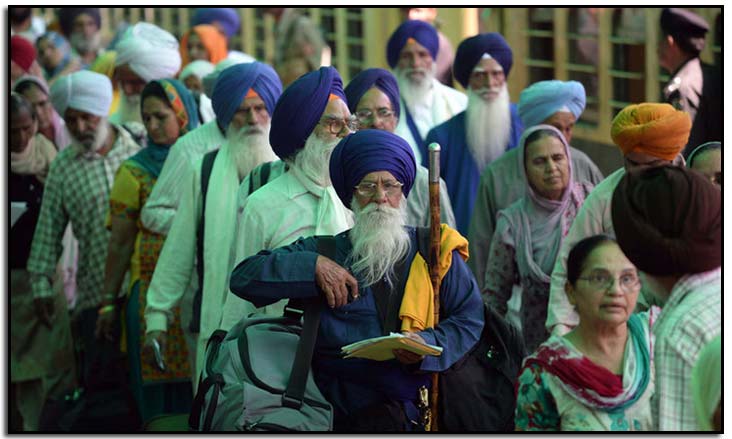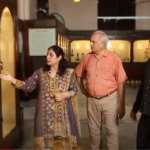Singer Anup Jalota’s bhajan ‘prabhuji tum chandan hum pani‘ played in the background as a saffron-robed priest purified Krishna, Radha and Hanuman’s idols with milk for their installation at Lahore’s Krishna Temple in February 2007.
The temple on Ravi Road in Pakistan’s cultural capital was packed with devotees, many of whom occupied the corridor and stairs to witness the unusual murti sathapna amid Hindu chants.
The India-Pakistan detente (2003-2008) had allowed a group of Indian pilgrims’ to carry out the first sathapna at the temple since partition virtually emptied out Hindus and Sikhs of west Punjab and Muslims of the region’s eastern part.
The sathapna was perhaps the little-known high-point of the thaw before the attacks on Mumbai derailed the process in 2008.
The inclusion of religious tourism now in the recently-announced India-Pakistan dialogue should allow the two countries to pick up the threads on this front to promote greater people-to-people contact.
The 2005 restoration of Katas Raj temple complex in Pakistan’s Punjab provides the blueprint for taking the process forward.
Ex-deputy prime minister L. K. Advani’s choice for inaugurating the restoration project was highly symbolic and contributed to goodwill during that period.
It showed the willingness to move beyond the toxic legacy of partition and Advani’s Babri Masjid demolition campaign, which triggered anti-Muslim violence reminiscent of grisly bloodbath in 1947.
The first religious service at Katas since partition was held with much fanfare in 2006. But tense India-Pakistan ties have left its religious tourism potential unrealised.
Religious tourism is perhaps the best way to engage the religious right, which is seen to be most resistant to altering status quo in bilateral ties. It is the lowest-hanging fruit that could be harnessed for a positive impact on solving more fractious issues.
Cross-border Muslim and Sikh religious tourism has thrived for decades. And addition of two shrines associated Hindu triumvirate’s third god, Shiva, to it in Pakistan — Katas and Hinglaj — can potentially generate unparalleled goodwill.
Katas’s importance to the Hindu mythology could draw Indian pilgrims in droves if they are encouraged like Sikhs. Seven temples in Katas are dedicated to Amar Kund. It is one of the two sacred ponds believed to have been created after Lord Shiva’s tears fell on the earth at Katas and Pushkar as he mourned his consort, Sati.
Even Mahabharata protagonist Yudhishthira is said to have passed his wisdom test at Katas to bring his four siblings to life during their exile there.
Over a thousand-km away, Mata Hinglaj Temple in Baluchistan’s remote mountains is one of 52 shaktipeeths believed to have been created at places where body parts of Shiva’s consort, Parvati, had fallen.
In Hinglaj, Parvati’s forehead with vermillion mark had fallen after Shiva took her corpse around following her self-immolation.
Singer Anup Jalota’s bhajan ‘prabhuji tum chandan hum pani’ played in the background as a saffron-robed priest purified Krishna, Radha and Hanuman’s idols with milk for their installation at Lahore’s Krishna Temple in February 2007.
The temple on Ravi Road in Pakistan’s cultural capital was packed with devotees, many of whom occupied the corridor and stairs to witness the unusual murti sathapna amid Hindu chants.
The India-Pakistan detente (2003-2008) had allowed a group of Indian pilgrims’ to carry out the first sathapna at the temple since partition virtually emptied out Hindus and Sikhs of west Punjab and Muslims of the region’s eastern part.
The sathapna was perhaps the little-known high-point of the thaw before the attacks on Mumbai derailed the process in 2008.
The inclusion of religious tourism now in the recently-announced India-Pakistan dialogue should allow the two countries to pick up the threads on this front to promote greater people-to-people contact.
The 2005 restoration of Katas Raj temple complex in Pakistan’s Punjab provides the blueprint for taking the process forward.
Ex-deputy prime minister L. K. Advani’s choice for inaugurating the restoration project was highly symbolic and contributed to goodwill during that period.
It showed the willingness to move beyond the toxic legacy of partition and Advani’s Babri Masjid demolition campaign, which triggered anti-Muslim violence reminiscent of grisly bloodbath in 1947.
The first religious service at Katas since partition was held with much fanfare in 2006. But tense India-Pakistan ties have left its religious tourism potential unrealised.
Religious tourism is perhaps the best way to engage the religious right, which is seen to be most resistant to altering status quo in bilateral ties. It is the lowest-hanging fruit that could be harnessed for a positive impact on solving more fractious issues.
Cross-border Muslim and Sikh religious tourism has thrived for decades. And addition of two shrines associated Hindu triumvirate’s third god, Shiva, to it in Pakistan — Katas and Hinglaj — can potentially generate unparalleled goodwill.
Katas’s importance to the Hindu mythology could draw Indian pilgrims in droves if they are encouraged like Sikhs. Seven temples in Katas are dedicated to Amar Kund. It is one of the two sacred ponds believed to have been created after Lord Shiva’s tears fell on the earth at Katas and Pushkar as he mourned his consort, Sati.
Even Mahabharata protagonist Yudhishthira is said to have passed his wisdom test at Katas to bring his four siblings to life during their exile there.
Over a thousand-km away, Mata Hinglaj Temple in Baluchistan’s remote mountains is one of 52 shaktipeeths believed to have been created at places where body parts of Shiva’s consort, Parvati, had fallen.
In Hinglaj, Parvati’s forehead with vermillion mark had fallen after Shiva took her corpse around following her self-immolation.
Ex-defence minister Jaswant Singh had led a group of Indian pilgrims to Hinglaj for the first time since partition in February 2006.
The fresh peace process could boost reopening of shrines like Sharda Peeth, dedicated to Goddess Saraswati on the Pakistani side of Kashmir, and become symbols of enduring peace if India-Pakistan ties do not take the familiar schizophrenic trajectory.
— Times News Network, Dec 27, 2015












